There can be your advertisement
300x150
History of High-Rise Construction in Moscow
When did the first skyscraper appear in Moscow, what do horizontal skyscrapers represent, and what was the original concept of Moscow City? Read about this and more in our article
The desire to go upward is one of the main things for humanity. From Egyptian pyramids to Gothic cathedrals, from the Tower of Babel to Burj Khalifa in Dubai – people try to reach the heavens, demonstrating their power, wealth, and authority. But no powerful ruler will be able to build a tall building without talented engineers. Moscow was no exception: over the last 150 years, it has confidently moved upward.
But where did it all begin? We tell the story together with Ayrat Bagautdinov, founder of the educational project "Moscow Through the Eyes of an Engineer".
Ayat Bagautdinov
EXPERT
Civil engineer by education, historian, and teacher by heart. Conducts tours, lectures for adults, and engaging lessons for children and teenagers.
Skyscrapers or Skyscrapers?
The homeland of skyscrapers is rightly considered... no, not New York, but Chicago! In 1872, a terrible fire occurred there, which, to the great delight of developers, opened up incredible opportunities for construction. The real building fever began! Land became more and more expensive each day, and everyone wanted to buy less land but build more square meters. And so buildings began to rise upward!
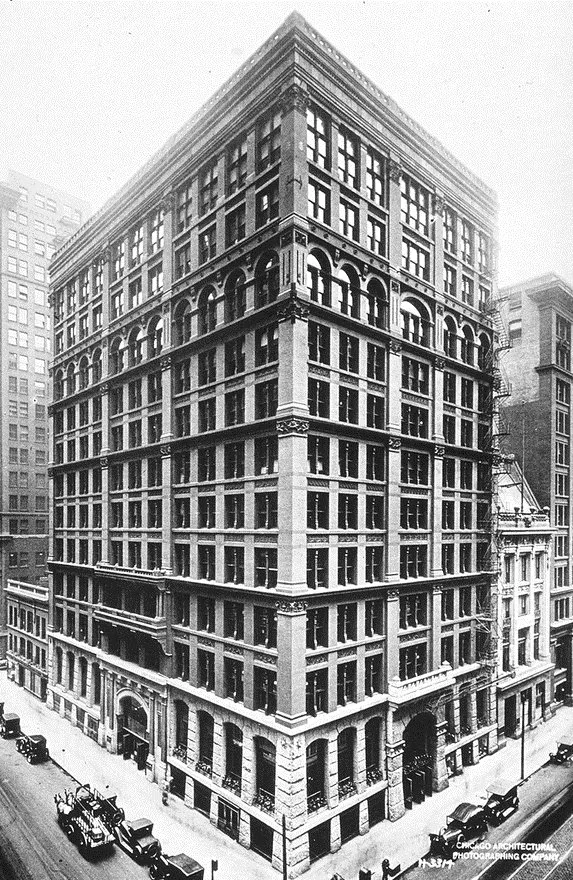 Insurance Building in Chicago
Insurance Building in ChicagoThe first skyscraper is considered the Insurance Building, built in Chicago in 1885. Today, it causes confusion: what kind of skyscraper is this – only 10 floors?! But what's important here is that architect William Jenney created the first high-rise building entirely on a steel frame. Brick walls here serve only as screens: protecting from weather and decorating the building.
In Russia at that time, things were more modest: we had plenty of land, so we could grow wider. But post-reform capitalism dictated its conditions, and in the early 20th century, Moscow developers also began to rise upward.
The first one was the alcohol magnate Afremov, who built a profitable house on Sadovaya-Spasskaya near the current Krasnye Vorota metro station. With its eight floors and 35 meters in height, Afremov's House became the tallest building in Moscow. Rumors said that Moscow residents hurried to cross to the other side of the street, fearing it might collapse on them. Today, Afremov's House looks modestly, squeezed by height at Krasnye Vorota and the massive Ministry of Agriculture building.
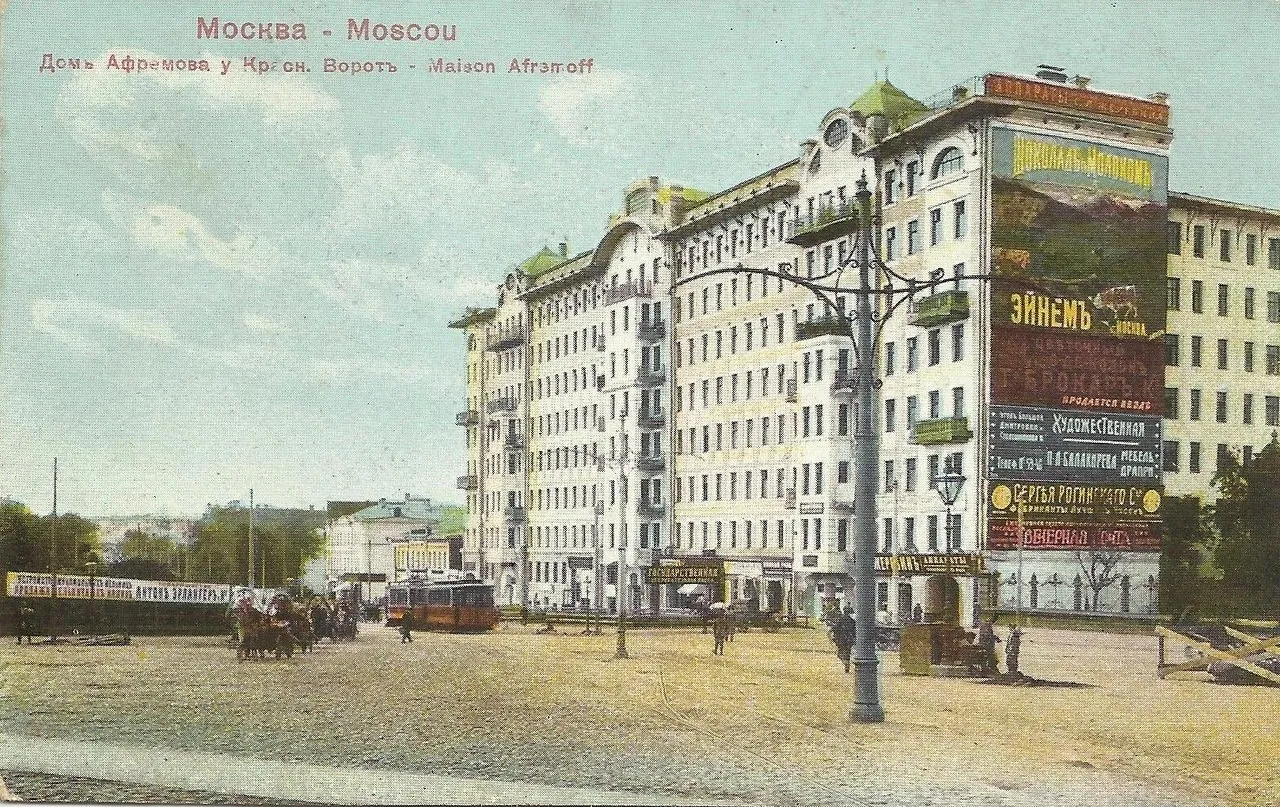 Afremov's House
Afremov's HouseNirnsee House
But Afremov didn't celebrate for long and proposed in his advertising brochures to live in the tallest house in Moscow – eight years later, this status passed to Nirnsee House on Tverskoy Boulevard. Ernst Nirnsee – both an architect and the owner of the house – built a giant that was 10 (!) floors high and 40 meters tall.
The house had an interesting, speaking in modern terms, concept – a house for bachelors. Small (in pre-revolutionary terms) studios compensated for well-developed public spaces: the restaurant "Roof" and the cabaret theater "Flying Mouse". Today, the house on Tverskaya is hard to recognize – it was sheltered by a Stalinist residential building at the corner of Tverskaya and Tverskoy Boulevard.
I consciously refrained from calling these Moscow buildings skyscrapers. There was no such word in the Russian language at that time. Instead of an English loanword, our ancestors called tall buildings "tucherez" (cloud piercers). With current linguistic reforms, when coffee can be of the middle gender and a contract can have stress on the last syllable, perhaps it will be possible to bring this poetic Russian word back into use.
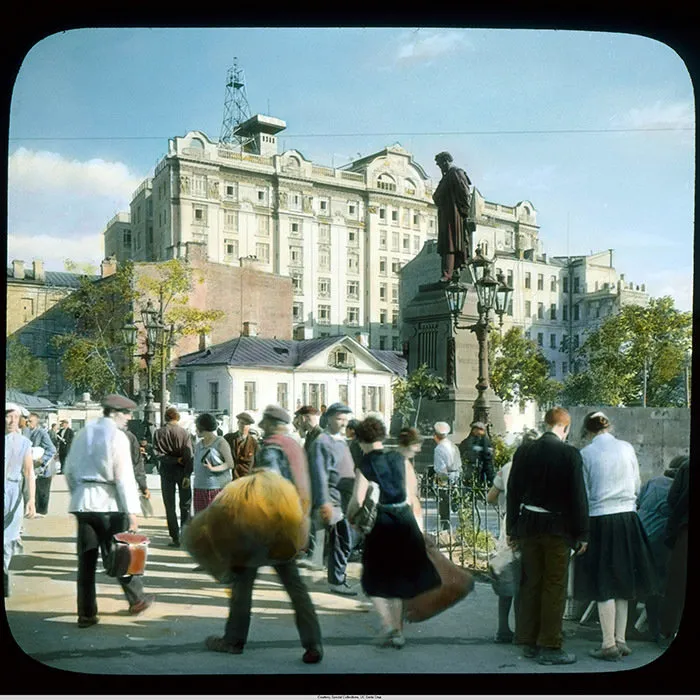 Nirnsee House
Nirnsee HouseRotating Houses and Horizontal Skyscrapers
The young Soviet republic had great ambitions, and it immediately needed to establish its birth by setting up a couple of tall buildings in the centers of both capitals.
In 1919, the famous constructivist artist Vladimir Tatlin designed the Monument to the Third International, which was not just a monument but a skyscraper 400 meters tall. According to the author's plan, inside the huge spiral were supposed to be arranged three parts of the building, each rotating at its own speed: cubic legislative assembly – one rotation per year, pyramidal executive committee – one rotation per month, cylindrical press center – one rotation per day.
 Vladimir Tatlin. Project of the Monument to the Third International
Vladimir Tatlin. Project of the Monument to the Third InternationalLazar Lissitzky. Project of Horizontal Skyscrapers
In 1923, the artist and architect Lazar Lissitzky proposed unprecedented "horizontal skyscrapers" for Moscow. Large horizontally placed administrative buildings were supposed to be raised to a height of 50 meters on three legs – supports, inside which elevators and stairwells were to be placed. By two legs, employees of institutions could directly reach the metro, and at the base of the third leg, a tram stop was to be arranged. Lissitzky proposed placing horizontal skyscrapers at the intersection of boulevards and radial streets (Red Square, Nikitskiye Vorota, etc.).
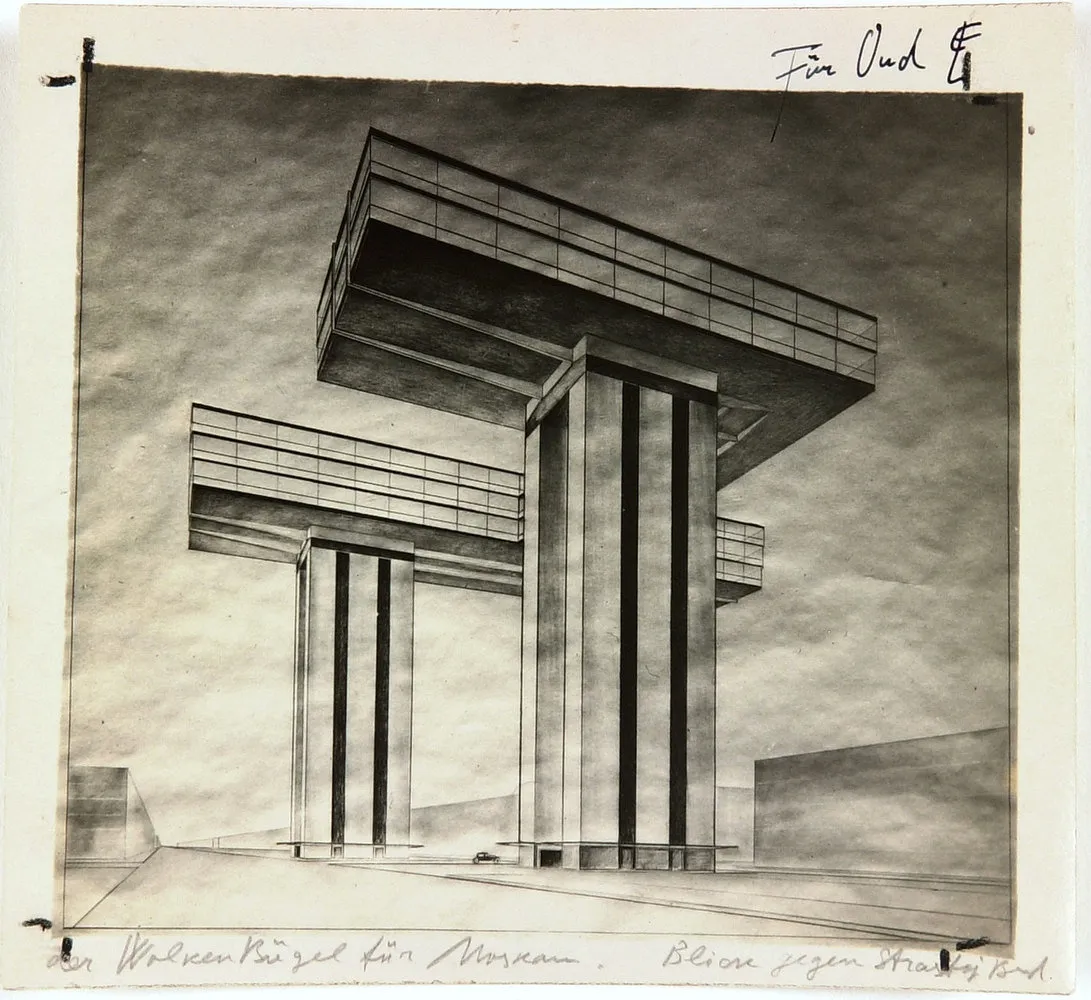
Architects of the 1920s were full of fantasy and creative courage! But Soviet power also had nowhere to occupy... money, so these revolutionary projects were shelved until better times. It should just be said that the first rotating skyscraper was built in the Brazilian city Curitiba in 2002, and a nearly identical copy of Lissitzky's horizontal skyscraper was recently built in Beijing as the headquarters of China Central Television.
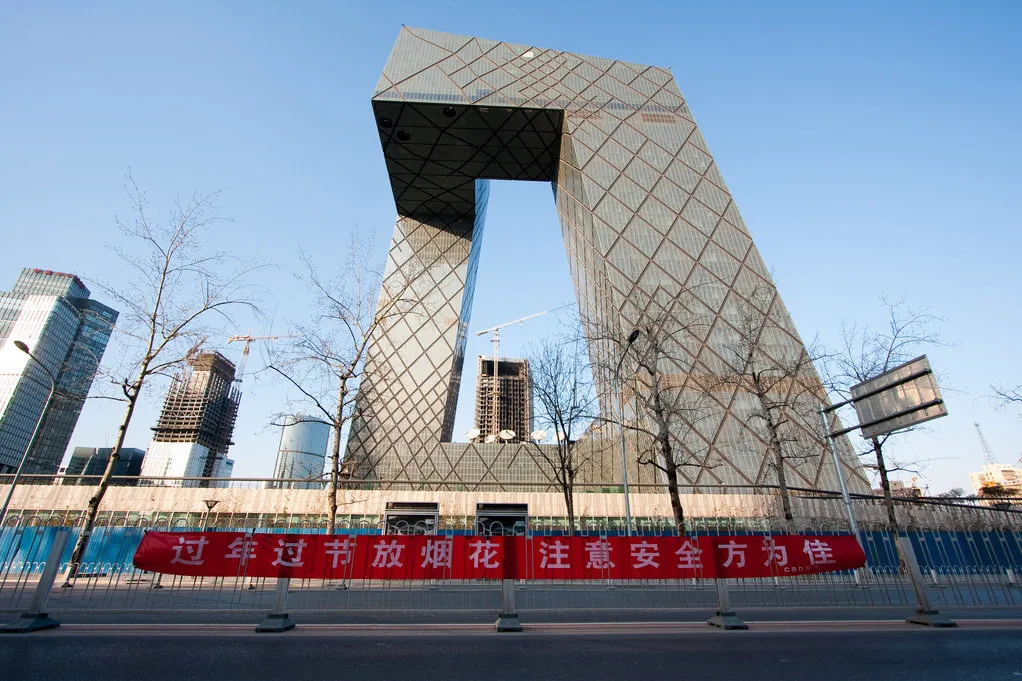 CCTV Headquarters, Beijing
CCTV Headquarters, BeijingWe Are Born to Make Kafka's Fables Reality
But what failed for the Bolsheviks with their Red Terror and NEP, became possible during the strict Stalinist policy. There was no way to avoid height here – how else could one glorify the wise leader and the best Soviet power in the world?!
In the early 1930s, construction of the highest building on Earth (!) – the Palace of Soviets – began on the site of the demolished Church of Christ the Savior. Its height was to be 416 meters, with the last hundred meters being taken up by the colossal statue of Lenin. The giant building was to take 350,000 tons of steel (as much as 40 Eiffel Towers).
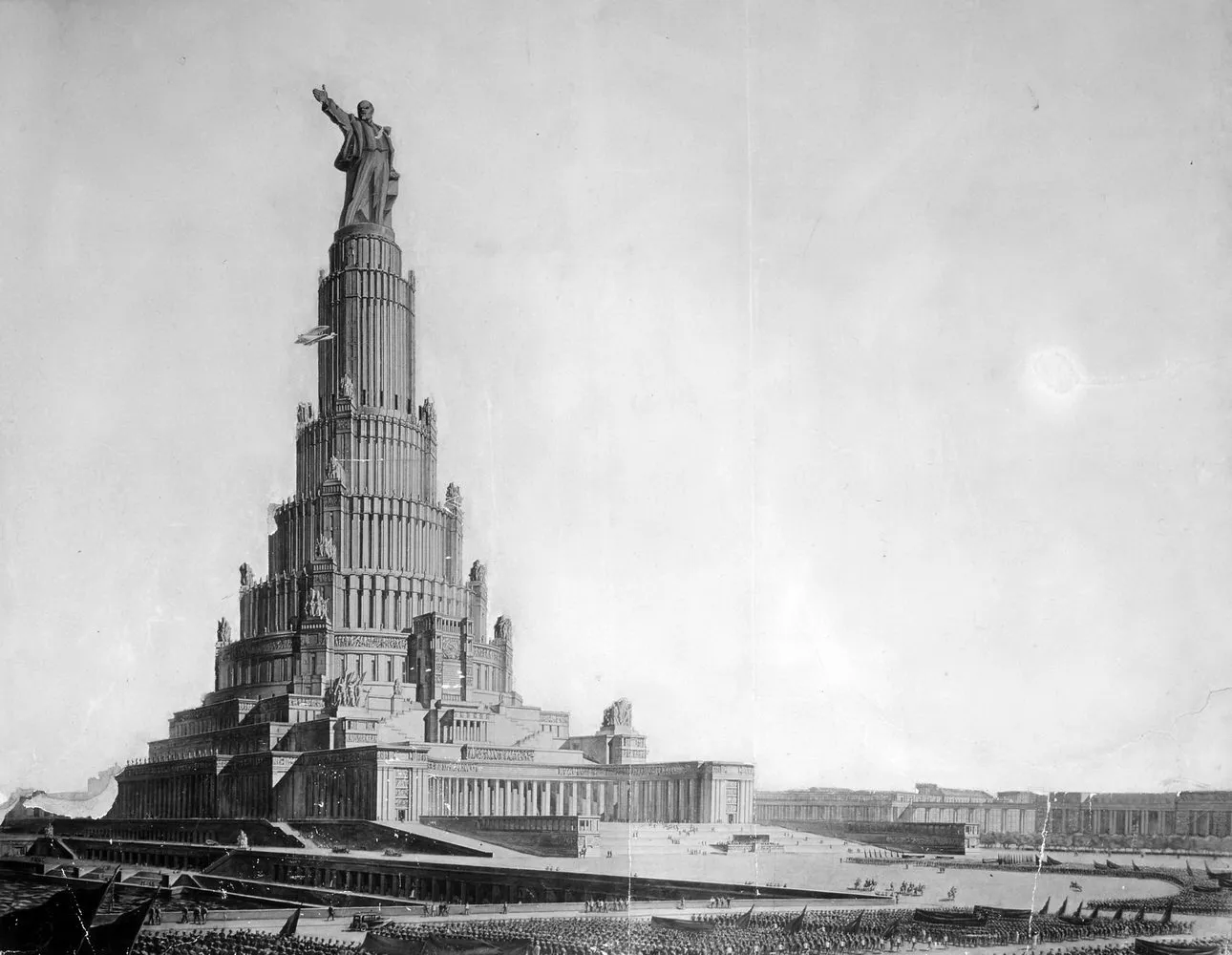 Boris Iofan. Project of the Palace of Soviets
Boris Iofan. Project of the Palace of SovietsBefore the war, foundations were completed, consisting of two concrete rings with diameters of 140 and 160 meters and a height of 20 meters. From dry numbers to images: imagine that standard five-story Khrushchev apartments started a dance around the Luzhniki Stadium. That's what those foundations were like... and they still are. Removing such a pile of concrete was not easy, and it still lies at the base of the restored Church of Christ the Savior.
Even four levels of steel frame were built, but the sudden war stopped construction. By the end of the war, there was no time for palaces – metal was needed more for restoring destroyed bridges and factories. Stalin never returned to the frozen project. Khrushchev tried to relocate the construction to the Vorobyovy Hills, and later even gave up on it entirely. On the former site, the largest open-air pool in Europe (still – on such foundations!) "Moscow" was built, and in the early 1990s, the Church was restored.
 Construction of the Palace of Soviets Foundations
Construction of the Palace of Soviets FoundationsStalin's Sisters
But after the Great Patriotic War, it was necessary to show both our people and the whole world that we are a victorious country. Stalin chose a compromise project: instead of one Palace of Soviets, build eight (!) tall buildings. Paradoxically enough, all together they were cheaper than the colossal Palace.
Here's where the first inconsistency appears: Ministry of Foreign Affairs, Barbakane Street, Krasnye Vorota, Kotelniki, Ukraine, Leningradskaya, MGU… Where is the eighth skyscraper? The tallest sister was supposed to grow in Zaryadye. By the way, 275 meters! Can you imagine a tower 30 meters taller than the main building of MGU standing right on Red Square? Fortunately, it was not completed before Stalin's death and repeated the fate of the Palace of Soviets – on its foundations in the 1960s, the "Russia" hotel was built. And now, it's been demolished to make way for the park "Zaryadye".
 Panorama of Red Square with the Skyscraper in Zaryadye
Panorama of Red Square with the Skyscraper in ZaryadyeThe tallest became the sister located on the Vorobyovy Hills. The main building of MGU, at a height of 235 meters, became the tallest building not only in the Soviet Union but also in all of Europe. And we held this status for 37 years – only in 1990 were we overtaken by Germany.
The main building of MGU (as well as other sisters) was based on a steel frame designed by the remarkable engineer Nikolai Nikolaev. He knew how to build tall – just say that Nikolaev later created the Ostankino Tower, which is still the tallest structure in Europe.
The last 50 meters of the MGU height consist of a spire. 50 meters is 16 floors of an average multi-apartment house. To build such a spire, an original technology was invented: it was built in a special shaft at the center of the tower and then "pulled out" from the building like a fishing rod or radio antenna.
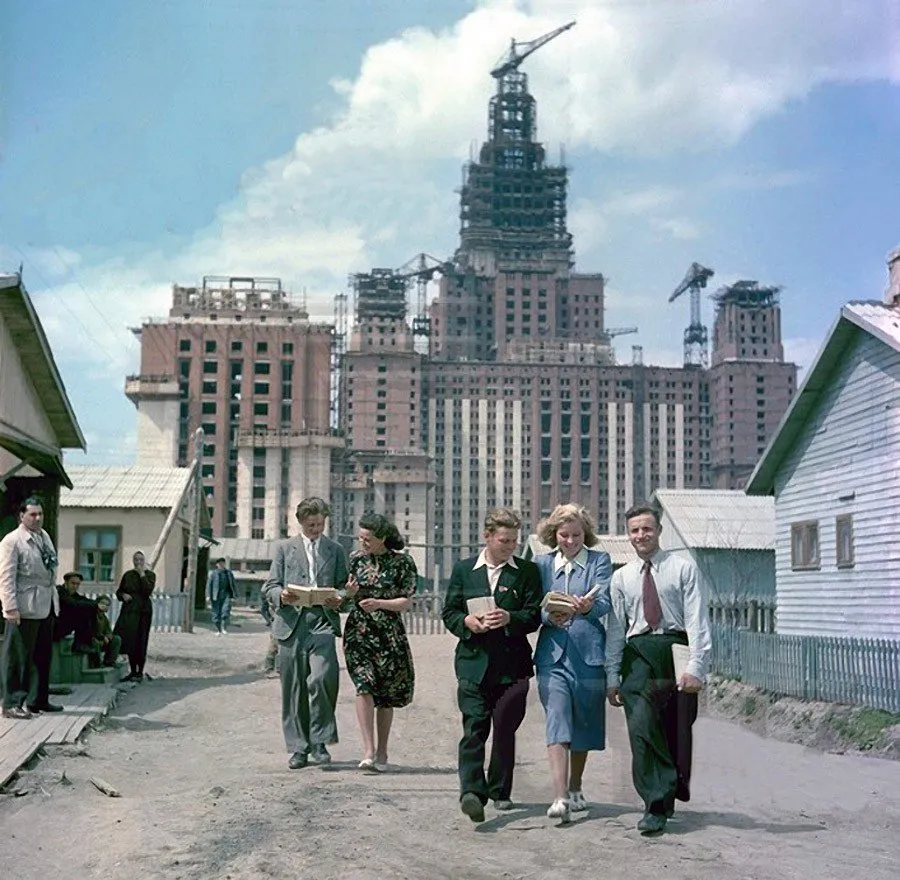 Construction of the Main Building of MGU
Construction of the Main Building of MGUNew Russia
The second half of Soviet history was much more grounded, and it never managed to outdo Stalin's sisters: the House of the Council of Economic Mutual Assistance (now the Government House of Moscow on Novy Arbat) and the White House barely surpassed the 100-meter mark.
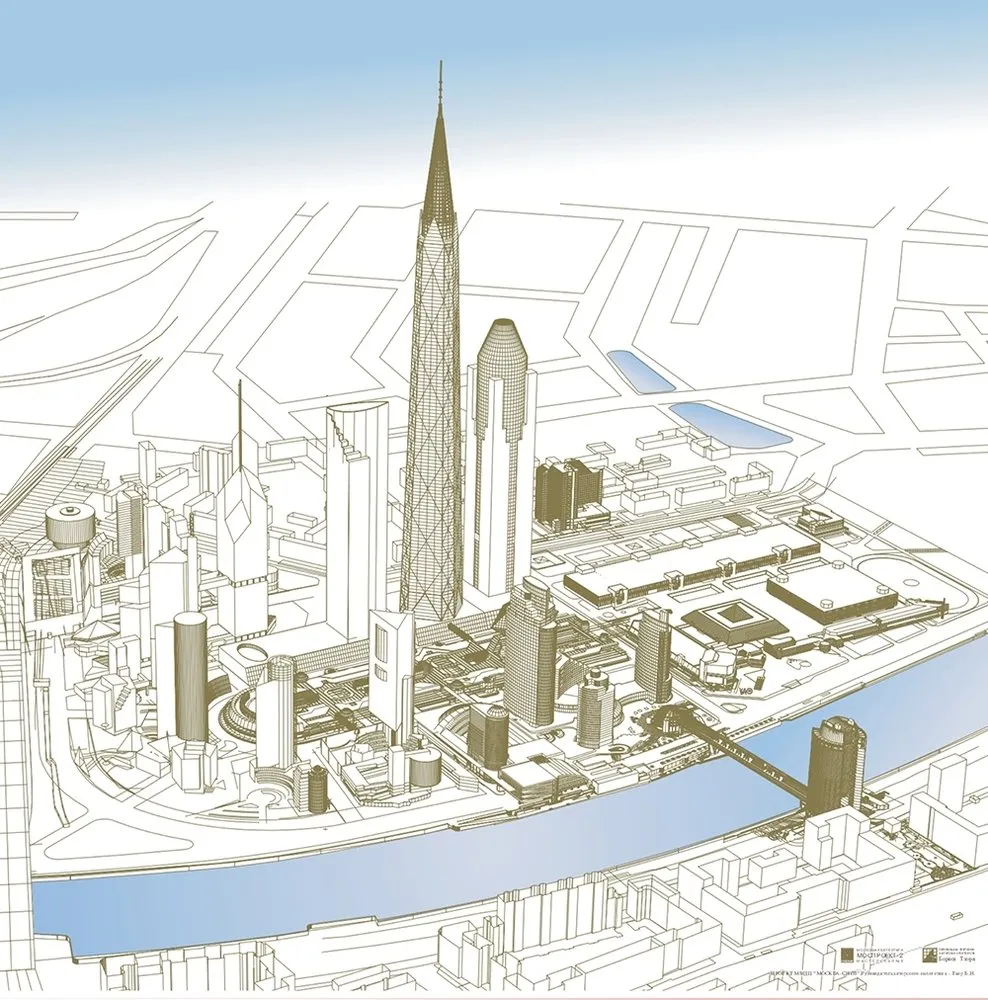 Early Moscow City Project by Boris Thor
Early Moscow City Project by Boris ThorBut with the beginning of a new, democratic Russia, authorities again needed to establish themselves through unprecedented constructions. For Moscow, such a construction was the business center Moscow City. According to legend, the idea of the City was proposed by architect Boris Thor to Lukyanov, the author of the Olympic Sports Complex and co-author of Novy Arbat. According to Thor's plan, the skyscrapers embraced a U-shaped park, gradually growing taller as they moved from the Bagration Bridge toward the Russia Tower in the northeast corner of the site. Thus, the low-rise buildings on the southern side of the City would not block the views from the northern side to the city and river.
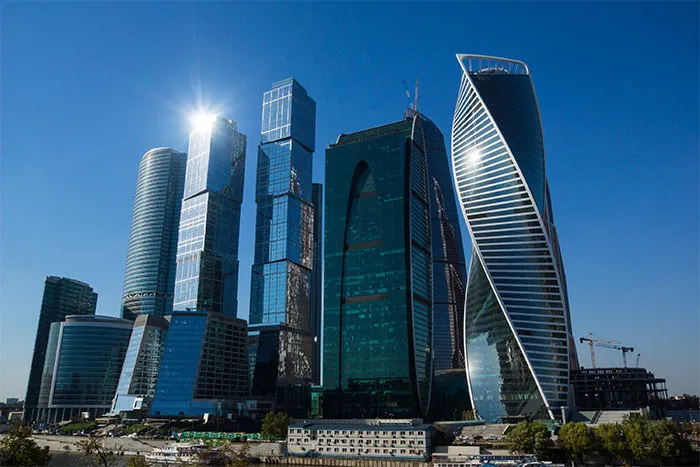 Moscow City. Modern View
Moscow City. Modern ViewFrom the idea of Thor, who died in 2009 before seeing the construction completed, little remains. Instead of a park, a huge mall rose, and skyscrapers began competing with each other in growth (as if the master plan were a competition, and everyone wants to sell more space!). Today, the Federation-East tower is the tallest building in Russia and Europe. Beating all European competitors, Moscow reclaimed its status as the owner of the tallest building in our part of the world.
One can relate to Moscow's high-rise buildings differently. Some are amazed by their luxurious and imposing appearance, while others accuse them of inhumane treatment towards the architectural integrity of the city. But one thing is undeniable: tucherez, high-rises, skyscrapers not only reach for the heavens themselves but also push our economy, investment attractiveness, and city image higher. And... Russian engineering school. For this reason, we engineers love them.
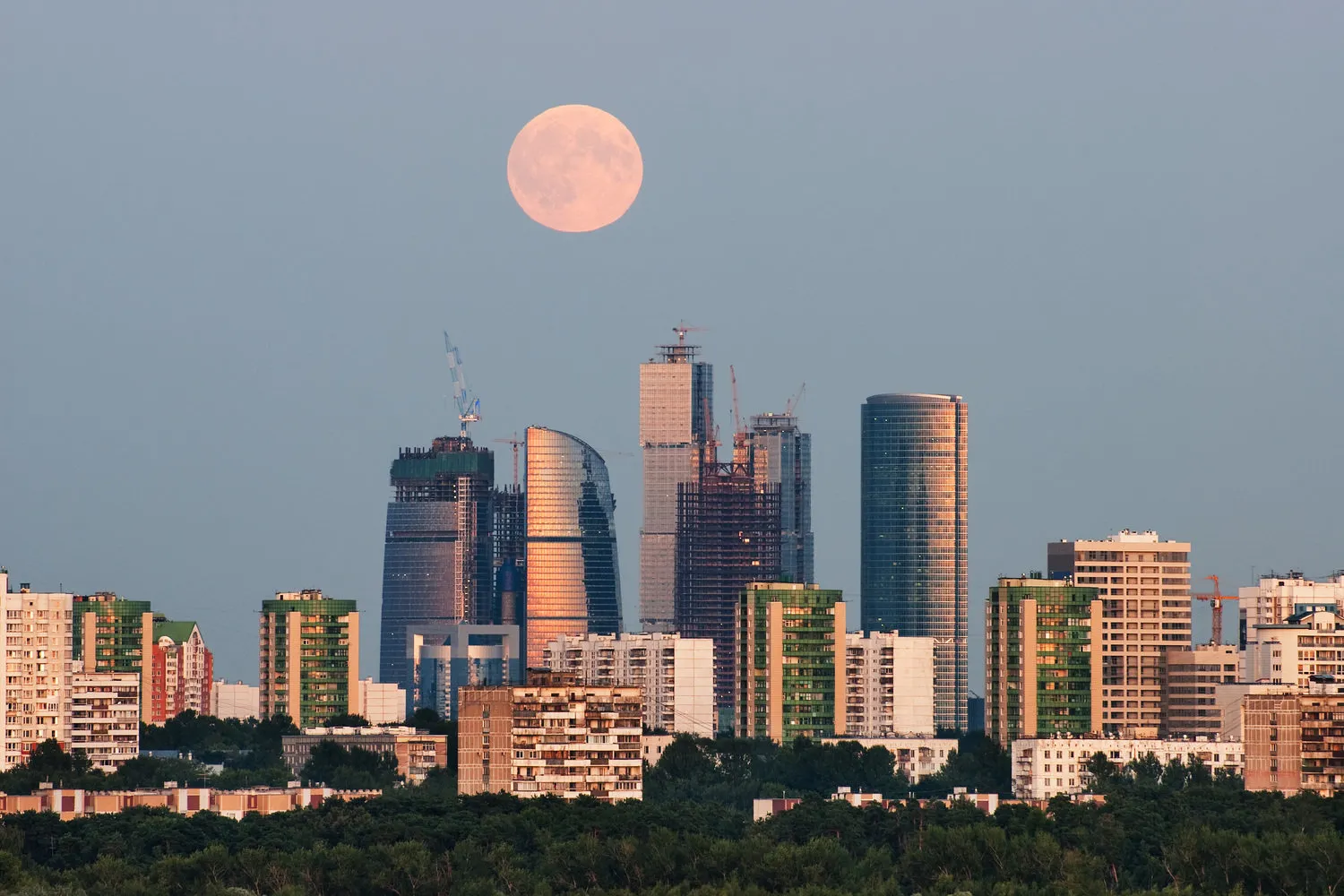 Read other posts about Moscow history: How the House on the Embankment Surprised Its ContemporariesWhy and How Did Moscow Commune Houses AppearWhat You Always Wanted to Know About the House of the People
Read other posts about Moscow history: How the House on the Embankment Surprised Its ContemporariesWhy and How Did Moscow Commune Houses AppearWhat You Always Wanted to Know About the House of the PeopleMore articles:
 How to Properly Maintain Plastic Windows: 7 Tips
How to Properly Maintain Plastic Windows: 7 Tips Quick Living Room Renovation: Step-by-Step Guide
Quick Living Room Renovation: Step-by-Step Guide To Combine or Not to Combine? Important Details of Bathroom Redesign
To Combine or Not to Combine? Important Details of Bathroom Redesign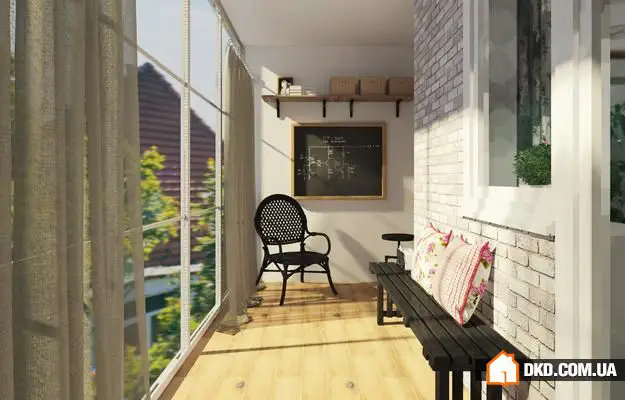 10 Reasons to Glass Your Balcony This Spring
10 Reasons to Glass Your Balcony This Spring How to Visually Raise the Ceiling: 7 Designer Tips
How to Visually Raise the Ceiling: 7 Designer Tips What to Consider in Apartment Design for Young Families: Tips from Professionals
What to Consider in Apartment Design for Young Families: Tips from Professionals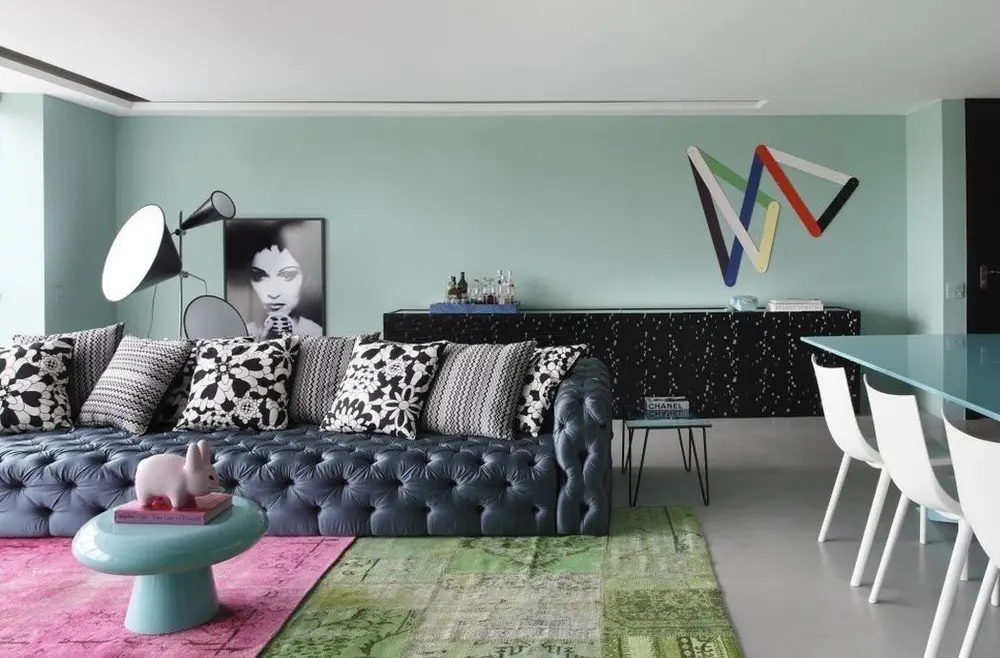 Interior Mistakes You Can Make
Interior Mistakes You Can Make 5 drawbacks of the hallway that can be fixed in a weekend
5 drawbacks of the hallway that can be fixed in a weekend